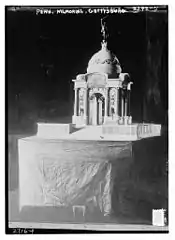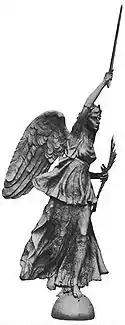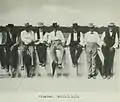Pennsylvania State Memorial, Gettysburg
The Pennsylvania State Memorial[2] is a monument in Gettysburg National Military Park that commemorates the 34,530 Pennsylvania soldiers who fought in the July 1 to 3, 1863 Battle of Gettysburg during the American Civil War. The memorial stands along Cemetery Ridge, the Union battle line on July 2, 1863.[3] Completed in 1914, it is the largest of the state monuments on the Gettysburg Battlefield.[4]
| Pennsylvania Monument[1]:69 | |
.jpg.webp) | |
| Coordinates | 39°48′27.32″N 77°14′6.55″W |
|---|---|
| Location | Gettysburg National Military Park |
| Designer | W. Liance Cottrell (Architect) Samuel Murray (Sculptor) |
| Completion date | 1914 |
| Opening date | September 27, 1910 |
History

In the 1880s, Senator Andrew G. Curtin, who had served as Pennsylvania's governor during the Civil War, advocated for a "Pennsylvania Memorial Hall" to be built atop Little Round Top.[5] The 60 ft (18 m)-square hall would display "a treasury of trophies and mementos of all the Pennsylvania regiments that fought at Gettysburg."[6] The proposed building was included in an 1889 state appropriations bill, that was vetoed by Governor James A. Beaver.[7]
Eighteen years later, the Pennsylvania Legislature appropriated $150,000 for construction of a state memorial, and the current site was announced in February 1909.[8] The design competition for the commission was won by the entry of New York architect W. Liance Cottrell and Philadelphia sculptor Samuel Murray.[2] The building was to be completed by July 1, 1910.[9]
Humphreys Avenue, along the east side of the memorial, was not surveyed until 1911, so materials were delivered by railroad, via the Round Top Branch to nearby Hancock Station.[10]
The memorial was unfinished when it was dedicated on September 27, 1910, and the project was out of money. An additional state appropriation of $40,000 was approved in 1911.[10] The new completion date was set for July 1, 1913 – the 50th anniversary of the battle. The portrait statues were installed in April 1913,[1]:69 and the memorial was rededicated on July 4, 1913. A bronze tablet listing the names of 945 additional Pennsylvania veterans completed the memorial in 1914.[4]
Description
The memorial features a square, granite pedestal (terrace) – 100 feet on each side – with bronze tablets on its exterior face that list the names of the 34,530 Pennsylvania soldiers who fought in the battle.[1] Set upon the pedestal is the granite pavilion, which consists of 4 corner towers linked by arches that form an arcus quadrifrons, or 4-sided triumphal arch.[1]:38 Engaged Ionic columns at the corners and flanking the arches form niches for the 8 portrait statues.[4] The pavilion is topped by a granite dome. Between the parapet and the dome's base is an observation deck, accessed by a spiral staircase in the northwest corner tower. Under the pavilion is an undercroft or vaulted cellar.[4] The memorial's entrance is on the west (Hancock Avenue) side, where a wide flight of steps rises to the pedestal's terrace. Half-flights rise beneath each arch into the pavilion's central hall.[11]
A bronze Nike figure, the Goddess of Victory and Peace, crowns the podium atop the dome. She holds a sword in one hand and a palm branch, a symbol of victory through peace, in the other. In a gesture to the Biblical passage "they shall beat their swords into plowshares," the bronze used to cast the Nike came from melted-down cannons.[12] Above the arches are spandrel bas-reliefs of winged goddesses, and above the cornice is a parapet with a bas-relief panel on each side that depicts the Artillery, Cavalry, Infantry and Signal Corps. Larger-than-life bronze statues of President Abraham Lincoln and other prominent Civil War figures flank the arches. Above them are bas-relief shields and laurel wreaths. The names of important figures in the battle are inscribed across the pavilion's frieze and on its interior.
Sculpture

- Goddess of Victory and Peace (1909–10) by Samuel Murray, atop the monument's dome. Height: 21 ft (6.4 m). Weight: 7,500 lb (3,402 kg).[13]
- Portrait statues:
- President Abraham Lincoln (1911–1913) by J. Otto Schweizer, west side
- Governor Andrew Curtin (1911–1913) by William Clark Noble, west side
- General George Meade (1911–1913) by Lee Lawrie, north side
- General John F. Reynolds (1911–1913) by Lee Lawrie, north side
- General Winfield Scott Hancock (1911–1913) by Cyrus Edwin Dallin, east side
- General David McMurtrie Gregg (1911–1913) by J. Otto Schweizer, east side
- General Alfred Pleasonton (1911–1913) by J. Otto Schweizer, south side
- General David B. Birney (1911–1913) by Lee Lawrie, south side
 Abraham Lincoln by J. Otto Schweizer
Abraham Lincoln by J. Otto Schweizer Gov. Andrew Curtin by William Clark Noble
Gov. Andrew Curtin by William Clark Noble Gen. George Meade by Lee Lawrie
Gen. George Meade by Lee Lawrie Gen. John F. Reynolds by Lee Lawrie
Gen. John F. Reynolds by Lee Lawrie General Winfield Scott Hancock by Cyrus Edwin Dallin
General Winfield Scott Hancock by Cyrus Edwin Dallin Gen. David McMurtrie Gregg by J. Otto Schweizer
Gen. David McMurtrie Gregg by J. Otto Schweizer Gen. Alfred Pleasonton by J. Otto Schweizer
Gen. Alfred Pleasonton by J. Otto Schweizer Gen. David B. Birney by Lee Lawrie
Gen. David B. Birney by Lee Lawrie
Architectural sculpture
- 4 white marble parapet bas-relief panels:
- Artillery (1909–10) by Samuel Murray, north parapet.
- Cavalry (1909–10) by Samuel Murray, south parapet.
- Infantry (1909–10) by Samuel Murray, west parapet. Pennsylvania Bucktails of Stone's Brigade at the McPherson Farm.[14]
- Signal Corps (1909–10) by Samuel Murray, east parapet.
- Attendants to Victory, 8 white marble bas-relief goddess figures (1909–10) by Samuel Murray, a pair in the spandrels above each arch.
- 8 white marble Shield & Laurel Wreath bas-reliefs (1909–10) by Samuel Murray, one in the niche above each portrait statue.
 Artillery
Artillery Cavalry
Cavalry Infantry
Infantry Signal Corps
Signal Corps Attendants to Victory (reclining goddesses above arch), north side
Attendants to Victory (reclining goddesses above arch), north side
Regimental memorials
The perimeter wall features 75 bronze plaques memorializing Pennsylvania units during the war.
 Gettysburg Address
Gettysburg Address 11th Infantry Regiment
11th Infantry Regiment 23rd Infantry Regiment
23rd Infantry Regiment 26th Infantry Regiment
26th Infantry Regiment 26th Emergency Infantry Regiment
26th Emergency Infantry Regiment 26th Emergency Infantry Regiment
26th Emergency Infantry Regiment 27th Infantry Regiment
27th Infantry Regiment 28th Infantry Regiment
28th Infantry Regiment 29th Infantry Regiment
29th Infantry Regiment 30th Infantry Regiment
30th Infantry Regiment 31st Infantry Regiment
31st Infantry Regiment 34th Infantry Regiment
34th Infantry Regiment 35th Infantry Regiment
35th Infantry Regiment 38th Infantry Regiment
38th Infantry Regiment 39th Infantry Regiment
39th Infantry Regiment 40th Infantry Regiment
40th Infantry Regiment 41st Infantry Regiment
41st Infantry Regiment 42nd Infantry Regiment
42nd Infantry Regiment 46th Infantry Regiment
46th Infantry Regiment 49th Infantry Regiment
49th Infantry Regiment 53rd Infantry Regiment
53rd Infantry Regiment 56th Infantry Regiment
56th Infantry Regiment 57th Infantry Regiment
57th Infantry Regiment 61st Infantry Regiment
61st Infantry Regiment 62nd Infantry Regiment
62nd Infantry Regiment 63rd Infantry Regiment
63rd Infantry Regiment 68th Infantry Regiment
68th Infantry Regiment 69th Infantry Regiment
69th Infantry Regiment 71st Infantry Regiment
71st Infantry Regiment 72nd Infantry Regiment
72nd Infantry Regiment 73rd Infantry Regiment
73rd Infantry Regiment 74th Infantry Regiment
74th Infantry Regiment 75th Infantry Regiment
75th Infantry Regiment 81st Infantry Regiment
81st Infantry Regiment 82nd Infantry Regiment
82nd Infantry Regiment 83rd Infantry Regiment
83rd Infantry Regiment 84th Infantry Regiment
84th Infantry Regiment 88th Infantry Regiment
88th Infantry Regiment 90th Infantry Regiment
90th Infantry Regiment 91st Infantry Regiment
91st Infantry Regiment 93rd Infantry Regiment
93rd Infantry Regiment 95th Infantry Regiment
95th Infantry Regiment 96th Infantry Regiment
96th Infantry Regiment 98th Infantry Regiment
98th Infantry Regiment 99th Infantry Regiment
99th Infantry Regiment 102nd Infantry Regiment
102nd Infantry Regiment 105th Infantry Regiment
105th Infantry Regiment 106th Infantry Regiment
106th Infantry Regiment 107th Infantry Regiment
107th Infantry Regiment 109th Infantry Regiment
109th Infantry Regiment 110th Infantry Regiment
110th Infantry Regiment 111th Infantry Regiment
111th Infantry Regiment 114th Infantry Regiment
114th Infantry Regiment 115th Infantry Regiment
115th Infantry Regiment 116th Infantry Regiment
116th Infantry Regiment 118th Infantry Regiment
118th Infantry Regiment 119th Infantry Regiment
119th Infantry Regiment 121st Infantry Regiment
121st Infantry Regiment 139th Infantry Regiment
139th Infantry Regiment 140th Infantry Regiment
140th Infantry Regiment 141st Infantry Regiment
141st Infantry Regiment 142nd Infantry Regiment
142nd Infantry Regiment 143rd Infantry Regiment
143rd Infantry Regiment 145th Infantry Regiment
145th Infantry Regiment 147th Infantry Regiment
147th Infantry Regiment 148th Infantry Regiment
148th Infantry Regiment 149th Infantry Regiment
149th Infantry Regiment 150th Infantry Regiment
150th Infantry Regiment 151st Infantry Regiment
151st Infantry Regiment 153rd Infantry Regiment
153rd Infantry Regiment 153rd Infantry Regiment
153rd Infantry Regiment 155th Infantry Regiment
155th Infantry Regiment 1st and 3rd Pennsylvania Artillery
1st and 3rd Pennsylvania Artillery Pennsylvania Light Artillery Batteries
Pennsylvania Light Artillery Batteries Pennsylvania General Officers
Pennsylvania General Officers
Maintenance
In 1921, the dome was lined with steel and sealed by William D. Gilbert and James Weikert and in 1929, the monument's copper was relined and defective woodwork was replaced.[10]:'30 The nearby comfort station was completed in 1933 as the first "Gettysburg Parkitecture" structure[15] using Gettysburg granite as in native colonial structures. A 1941 memorial bench of marble in front of the monument was broken by "unknown culprits" in 1952, and a marble bench was smashed in 1994.
Images
| External images | |
|---|---|
 Gettysburg veterans reading the bronze tablets, 50th anniversary of the battle, July 1913.
Gettysburg veterans reading the bronze tablets, 50th anniversary of the battle, July 1913. Gettysburg veterans seated on the terrace wall, 50th anniversary of the battle, July 1913.
Gettysburg veterans seated on the terrace wall, 50th anniversary of the battle, July 1913..jpg.webp) Pavilion's interior.
Pavilion's interior..jpg.webp) View from observation deck.
View from observation deck.
See also
| Wikimedia Commons has media related to Pennsylvania Memorial, Gettysburg. |
References
- Beitler, Lewis Eugene (editor and compiler) (December 31, 1913). Fiftieth Anniversary of the Battle of Gettysburg: Report of the Pennsylvania Commission (Google Books) (Report). Harrisburg, Pennsylvania: Wm. Stanley Bay (state printer). p. 173. Retrieved 2012-04-06.
"The Name of Every Pennsylvania Soldier Who Fought at Gettysburg is Recorded on These Bronze Tablets Adorning Her Memorial Monument.
(p. 22b) - "The Pennsylvania State Memorial". List of Classified Structures: GETT p. 20. National Park Service. Retrieved 2011-02-03.
Monument is a four-sided raised granite pedestal with bronze tablets listing Pennsylvania soldiers and set on a 100 foot square base. It has arched central passages to the domed interior. … Double bronze statues are located in niches on all four sides. Four oversized granite reliefs adorn the upper observation deck parapet walls.
External link in|work=(help) - "Touring the Battlefield" (PDF) (Map). Plan Your Visit. Cartography by NPS.gov. Retrieved 2011-02-03.
Union artillery held the line alone [near the site of the Pennsylvania Memorial] on Cemetery Ridge late in the [2nd] day as Meade called for infantry from Culp's Hill and other areas to strengthen and hold the center of the Union position.
- "Pennsylvania Memorial" (west-facing of 4 interpretive panels [HMdb.org transcription]). Gettysburg interpretive panels. FriendsofGettysburg.org. after "1998". Retrieved 2012-04-05. Check date values in:
|date=(help); External link in|publisher=(help) - "Pennsylvania Monument" (Google News Archive). Gettysburg Compiler. August 17, 1910. Retrieved 2011-03-06.
- Nicholson, John Page (1904). Pennsylvania at Gettysburg. W. S. Ray, printer. pp. 87, 90. Retrieved 2011-03-12 – via Internet Archive.
- "Pennsylvania Day: Great Crowds & Miserable Weather" (Google News Archive). The Star and Sentinel. September 17, 1889. Retrieved 2012-04-05.
One of the most interesting reunions was that of the Pennsylvania Reserves in the pavilion at Round Top Park.
- "Commission Selects Site,"The Gettysburg Times February 25, 1909.
- "Work to Start Immediately," The Gettysburg Times, May 9, 1909.
- "The Gettysburg Commission Reports" (weblist with transcribed versions: 1893–1921, 1927–1933). Gettysburg Discussion Group. Retrieved 2010-02-04. (original formats: 1895, '96, '97, '98, 1901-4, '09, '13, '18)
- The Pennsylvania State Memorial, from National Park Service.
- Loski, Diana. "The Pennsylvania Memorial: A Centennial". GettysburgExperience.com. Archived from the original on 2010-11-28. Retrieved 2011-02-03.
- Goddess of Victory and Peace, from SIRIS.
- James D. Ristine, Gettysburg: Vintage Postcard Views of America's Greatest Battlefield, Arcadia Publishing, 1999.
- "New Comfort Station to be Built on Field" (Google News Archive). Gettysburg Times. May 5, 1933. Retrieved 2011-04-11.